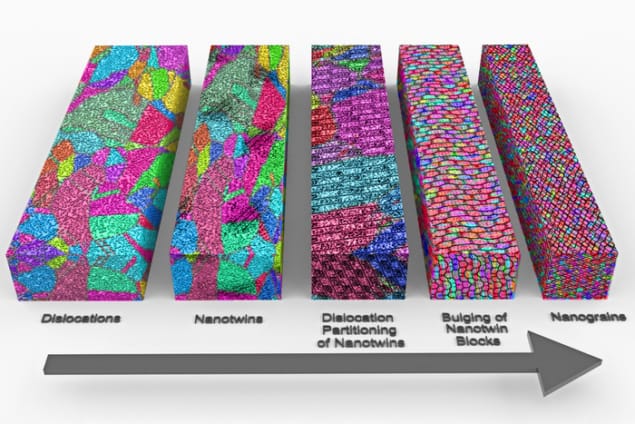‘Nanotwinning’ produces stronger metals
21 Jun 2022 Isabelle Dumé

When steel, aluminium and other widely used metals or alloys pass through industrial processes such as machining, rolling and forging, their nanoscale structure undergoes dramatic changes. Extremely fast production processes make it difficult to analyse these changes due to the sheer speed and small scale at which they take place, but researchers at the Massachusetts Institute of Technology (MIT) in the US have now succeeded in doing exactly that, pinning down what happens as crystal grains form in the metal under extreme deformation at the nanoscale. Their work could help in the development of metal structures with improved properties, such as hardness and toughness.
In general, the smaller these crystal grains are, the tougher and stronger the metal will be. Metallurgists often seek to shrink grain size by placing the metals under strain. One of the main techniques they use to do this is recrystallization, in which the metal is deformed at high strain and heated to produce finer crystals. In extreme cases, this process can produce grains with nanoscale dimensions.
“Not just a laboratory curiosity”
The MIT team led by Christopher Schuh has now determined how this high-speed, small-scale process takes place. They did this by using a laser to launch copper metal microparticles onto a metal at supersonic speeds and observing what happened when the particles struck it. Schuh points out that such high speeds are “not just a laboratory curiosity”, with industrial processes such as high-speed machining; high-energy milling of metal powder; and a coating method called cold spray all taking place at similar rates.
“We’ve tried to understand that recrystallization process under those very extreme rates,” he explains. “Because the rates are so high, no one has really been able to dig in there and look systematically at that process before.”
In their experiments, the researchers varied the speed and strength of the impacts and then studied the impacted sites using advanced nanoscale microscopy methods such as electron backscatter diffraction and scanning transmission electron microscopy. This approach allowed them to analyse the effects of increasing strain levels.
They found that the impacts dramatically refine the structure of the metal, creating crystal grains just nanometres across. They also observed a recrystallization process that was helped along by “nanotwinning” – a variation of a well-known phenomenon in metals called twinning, in which a specific kind of defect forms when part of the crystal structure flips its orientation.
Schuh and colleagues observed that the higher the impact rates, the more frequently nanotwinning took place. This leads to ever-smaller grains as the nanoscale “twins” break up into new crystal grains, they say. The process could increase the metal’s strength by about a factor of 10, which Schuh describes as non-negligible.
A better mechanistic understanding
Schuh describes the team’s result as an extension of a known effect called hardening that comes from hammer blows in ordinary metal forging. “Our effect is a sort of hyper-forging type of phenomenon,” he says. Although the result makes sense in that context, Schuh tells Physics World that it could lead to a better mechanistic understanding of how metal structures form, making it easier for engineers to design processing conditions to control these structures. “The very small, nanoscale structures we observed in our work are of interest for their extreme strength, for example,” he says.READ MORE

According to team member Ahmed Tiamiyu, the new findings could be directly applied right away to real-world metal production. “The graphs produced from the experimental work should be generally applicable,” he says. “They’re not just hypothetical lines.”
In the study, which is published in Nature Materials, the researchers focused on understanding the evolution of a metal’s structure during an impact. It would be interesting to study other characteristics, such as how the temperature around an impact site evolves, they say. “We are conducting work in this direction now,” Schuh reveals.

Isabelle Dumé is a contributing editor to Physics World
from physicsworld.com 29/6/2022
Δεν υπάρχουν σχόλια:
Δημοσίευση σχολίου